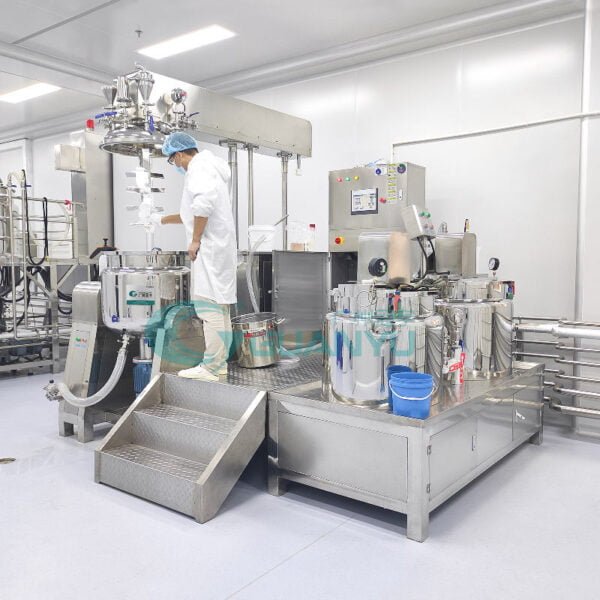อิมัลชันโฮโมจีไนเซอร์ :อิมัลชันและการทำให้เป็นเนื้อเดียวกัน
1. ภาพรวมและความแตกต่างที่สำคัญ
โลกวิทยาศาสตร์เป็นที่ตั้งของปรากฏการณ์และกระบวนการที่ซับซ้อนมากมายซึ่งมีบทบาทสำคัญในชีวิตประจำวันของเรา. ทรงกลมหนึ่งเกี่ยวข้องกับการนำสารที่ต้านทานสารผสมตามธรรมชาติมารวมกัน. ภายในทรงกลมนี้, คุณจะพบกับกระบวนการสำคัญสองกระบวนการของการอิมัลชันและการทำให้เป็นเนื้อเดียวกัน. แม้ว่าทั้งสองเทคนิคจะมีเป้าหมายสูงสุดในการผสมของเหลวร่วมกันก็ตาม, พวกเขาต่างกันในเรื่องวิธีที่จะไปถึงจุดหมายปลายทาง. การทำความเข้าใจและสำรวจความแตกต่างเหล่านี้เป็นก้าวแรกสู่การเห็นคุณค่าของบทบาทการเปลี่ยนแปลงของระบบอิมัลชันโฮโมจีไนเซอร์.
2. วิทยาศาสตร์เบื้องหลังการทำให้เป็นอิมัลชัน
การทำให้เป็นอิมัลชันเป็นกระบวนการพื้นฐานในการสร้างอิมัลชัน ซึ่งเป็นส่วนผสมที่เป็นเนื้อเดียวกันของของเหลวที่ไม่สามารถผสมกันได้สองชนิด. อิมัลชันอาศัยการสนับสนุนที่สำคัญต่อภารกิจของอิมัลซิไฟเออร์, เช่นสบู่และผงซักฟอก, ที่คร่อมของเหลวทั้งสองอย่างมีความสุขและบังคับให้พวกมันปะปนกัน. ดำเนินการในอุตสาหกรรมที่ใช้เครื่องผสมแบบพิเศษ, อิมัลซิไฟเออร์ได้รับการสนับสนุนจากการกระทำของอิมัลซิไฟเออร์ เช่น สารลดแรงตึงผิว. สารเคมีเหล่านี้ช่วยเพิ่มความเสถียรทางจลน์ของส่วนผสม, ป้องกันการแยกของเหลวที่ผสมโดยไม่ได้ตั้งใจ. การทำให้เป็นอิมัลชันมีวัตถุประสงค์หลักสามประการ: สร้างความมั่นใจในความเสถียรทางเคมีกายภาพของผลิตภัณฑ์, การกำหนดโครงสร้างของอิมัลชัน, และสร้างคุณสมบัติทางประสาทสัมผัสที่ต้องการ เช่น รูปลักษณ์และเนื้อสัมผัส.

3. ความซับซ้อนของการทำให้เป็นเนื้อเดียวกัน
ในทางตรงกันข้าม, การทำให้เป็นเนื้อเดียวกันมุ่งเน้นไปที่การสร้างสารละลายที่สม่ำเสมอจากของเหลวที่ไม่ละลายร่วมกันสองชนิด. ซึ่งสามารถทำได้โดยการแปลงคู่ที่ท้าทายให้กลายเป็นอิมัลชัน. ประถมศึกษาและมัธยมศึกษาเป็นสองเสาหลักของการทำให้เป็นเนื้อเดียวกัน, ครั้งแรกที่เกี่ยวข้องกับของเหลวแยกกันสร้างอิมัลชันโดยตรง, อย่างหลังคือการลดขนาดหยดภายในของเหลวที่มีอยู่. กระบวนการนี้อำนวยความสะดวกโดยอุปกรณ์ที่เรียกว่าโฮโมจีไนเซอร์, ซึ่งใช้พลังของแรงกดดันและแรงเฉือนที่รุนแรงเพื่อสลายและกระจายอนุภาคภายในของเหลวของฝ่ายตรงข้าม.

4. การเปรียบเทียบอิมัลชันและการทำให้เป็นเนื้อเดียวกัน
ในขณะที่ทั้งอิมัลชันและการทำให้เป็นเนื้อเดียวกันเกี่ยวข้องกับการผสมของเหลวที่ผสมไม่ได้, ธรรมชาติของกระบวนการทำให้พวกเขาแตกต่าง. อิมัลชันส่งผลให้เกิด 'อิมัลชัน’ ผ่านการกระจายตัวของของเหลวที่ไม่สามารถละลายได้ตัวหนึ่งภายในอีกของเหลวหนึ่ง, ในขณะที่การทำให้เป็นเนื้อเดียวกันจะถึงจุดสูงสุดใน 'สารละลายที่เป็นเนื้อเดียวกัน'’ โดยการผสมของเหลวสองชนิดที่ผสมกัน. ตารางด้านล่างนี้แสดงให้เห็นความแตกต่างที่สำคัญอย่างชัดเจน:
| การทำให้อิมัลชัน | การทำให้เป็นเนื้อเดียวกัน |
| การสร้างอิมัลชัน | การสร้างสารละลายที่เป็นเนื้อเดียวกัน |
| สารลดแรงตึงผิวเป็นอิมัลซิไฟเออร์ | Homogenizers เป็นผู้อำนวยความสะดวก |
| รับประกันความเสถียรทางเคมีกายภาพ | รับประกันการผสมที่สม่ำเสมอ |
| ลักษณะโครงสร้างที่กำหนด | ช่วงการใช้งานที่กว้าง |
| คุณสมบัติทางประสาทสัมผัส เช่น รูปร่างหน้าตา, พื้นผิว | เหมือนกันตลอดการผสมผสาน |
5. ความคิดสรุปเกี่ยวกับอิมัลชันและการทำให้เป็นเนื้อเดียวกัน
สรุป., ทั้งการทำให้เป็นอิมัลชันและการทำให้เป็นเนื้อเดียวกันเป็นเครื่องมือในการเตรียมของเหลวสำหรับการใช้งานที่หลากหลายในอุตสาหกรรมต่างๆ. อย่างไรก็ตาม, ประเด็นสำคัญที่ควรทราบก็คือในขณะที่การอิมัลชันเป็นเรื่องเกี่ยวกับการเตรียมอิมัลชัน, การทำให้เป็นเนื้อเดียวกันใช้หลักการเดียวกันเพื่อหมุนสารละลายที่เป็นเนื้อเดียวกัน. แม้จะมีแนวทางที่แตกต่างกันออกไป, เทคนิคทั้งสองมีตำแหน่งในโลกของอุตสาหกรรม, นำของเหลวที่ทนทานมาสู่การแต่งงานที่กลมกลืนกันตามความจำเป็นทางวิทยาศาสตร์. สะดุดตา, ระบบ Homogenizer Emulsion ถือเป็นจุดเด่นภายใน Homogenization, เปิดโอกาสมากมายด้วยความสามารถในการมิกซ์อันทรงพลัง.

